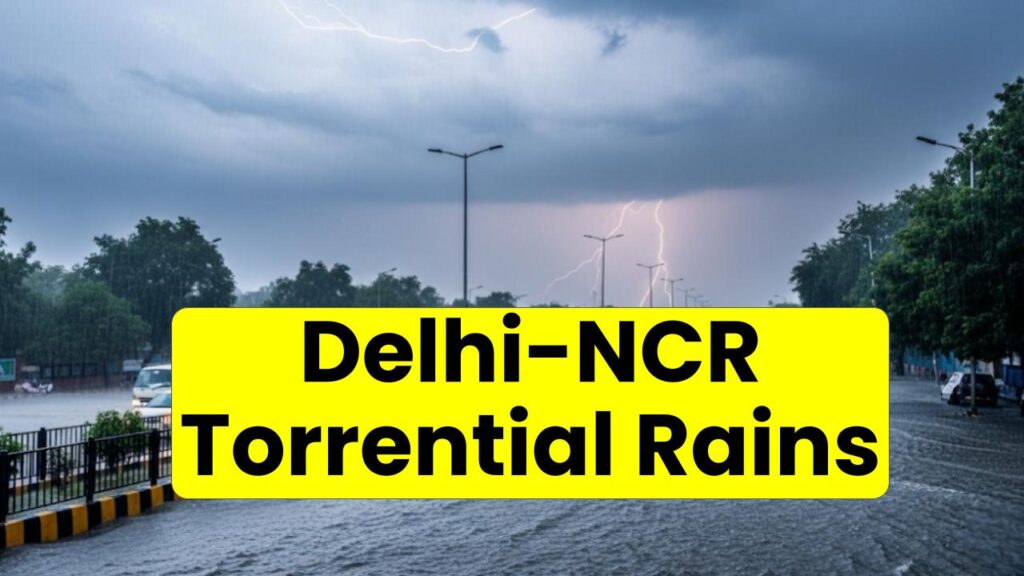Delhi-NCR has been facing an intense spell of torrential rains over the past few days, with the India Meteorological Department (IMD) issuing a red alert for parts of the region. What started as a moderate downpour has escalated into severe weather conditions, causing disruptions and raising concerns about potential flooding and damage. With more heavy rain forecasted over the next three days, the city and its surrounding areas are bracing for more chaos.

Delhi-NCR Torrential Rains
| Key Data | Details |
|---|---|
| Weather Alert | IMD issues red alert for Delhi-NCR due to heavy rainfall |
| Rainfall Impact | Waterlogging, disrupted traffic, possible localized flooding |
| Yamuna River Levels | Water discharge crossing 50,000 cusecs, raising flood concerns |
| Flight Operations | Stable, no significant delays at Indira Gandhi International Airport |
| Safety Measures | Avoid non-essential travel, stay updated with advisories |
Delhi-NCR is grappling with torrential rains, and the situation may worsen in the coming days. With a red alert in place and more rainfall expected, it’s crucial to stay informed and take precautions to protect yourself, your family, and your property. Follow weather updates from trusted sources like the IMD website, plan your travel wisely, and be cautious around waterlogged areas.
Understanding the Situation
Delhi, the bustling capital of India, is no stranger to heavy monsoon rains, but this year, the downpours have been particularly intense. Since July 20, the region has experienced torrential rainfall, which has led to waterlogging, traffic jams, and damage to infrastructure. The IMD’s latest forecast warns that the situation could worsen over the next few days, with more rain expected to hit the city.
The waterlogged streets have made commuting challenging, and parts of Delhi are witnessing reduced visibility due to the rain. More concerning, however, is the potential for flooding in low-lying areas, which could be exacerbated by rising water levels in the Yamuna River.
What’s Behind the Torrential Rains?
The ongoing torrential rains in Delhi-NCR can be attributed to a combination of monsoon systems and weather patterns. The monsoon winds, which bring heavy rains to many parts of India, have intensified due to a low-pressure area forming over the Bay of Bengal. This low-pressure system has contributed to the sustained rainfall in the capital, which is expected to continue for several more days.
Furthermore, the discharge of water from Haryana’s Hathnikund Barrage has raised the water levels in the Yamuna River, adding another layer of risk. The IMD has warned that this could lead to localized flooding, particularly in areas near the river.
Practical Advice and Safety Tips for the Next Few Days
If you live in or around Delhi-NCR, it’s essential to stay prepared for the unpredictable weather in the coming days. Here are some practical tips to help you navigate the situation safely:
1. Stay Updated on Weather Alerts
The IMD has been issuing regular updates, and it’s crucial to stay informed about the latest forecasts. Keep an eye on official sources like the IMD website for real-time weather alerts and warnings. Additionally, consider using weather apps on your phone to receive instant notifications about any sudden changes in weather conditions.
2. Plan Your Travel Wisely
Traffic disruptions are common during heavy rainfall, and waterlogging in low-lying areas can cause significant delays. If you don’t need to travel, it’s best to stay indoors. If you must go out, consider using public transportation as much as possible to avoid getting stuck in traffic.
For those using personal vehicles, ensure your car is equipped with proper rain gear, like windshield wipers in good condition, and check tire pressure before venturing out. It’s also important to have an emergency kit with essentials like water, snacks, and a power bank.
3. Be Cautious Near Water Bodies
With the Yamuna River levels rising due to the water discharge from Hathnikund Barrage, areas near the river could be at risk of flooding. Residents near the riverbanks should stay alert and follow any evacuation orders issued by local authorities. Avoid going near water bodies, especially during the night, as visibility may be poor.
4. Protect Your Home
Heavy rainfall can lead to damage in your home, especially if your area is prone to waterlogging or flooding. To protect your property:
- Inspect your roof and windows for leaks and ensure they are sealed properly.
- Clear your drains and gutters to prevent water buildup.
- Move valuable items to higher ground if you live in a flood-prone area.
5. Keep Emergency Contacts Handy
In case of emergencies, always have a list of important numbers at hand, including local emergency services and medical facilities. Share your plans with family members, so they know your whereabouts in case of any unforeseen events.
The Role of the IMD in Weather Forecasting
The India Meteorological Department (IMD) plays a crucial role in providing weather forecasts and alerts to help the public prepare for extreme weather conditions. The IMD uses advanced satellite technology and meteorological data to predict weather patterns and issue timely warnings.
During severe weather events like the ongoing rains in Delhi-NCR, the IMD issues color-coded weather alerts to inform the public:
- Red Alert: Indicates extreme weather, with the potential for significant impact. Immediate action is required.
- Orange Alert: Signifies the likelihood of severe weather, and preparedness should be in place.
- Yellow Alert: A general cautionary message about possible adverse weather.
These alerts help local authorities manage resources and ensure that citizens are aware of the risks.
FAQs
Q1: Why is Delhi experiencing such heavy rainfall this year?
A1: The heavy rainfall in Delhi is due to intensified monsoon winds and a low-pressure system over the Bay of Bengal, which has led to consistent downpours.
Q2: How can I stay safe during the heavy rains?
A2: Stay updated on weather forecasts, avoid unnecessary travel, and ensure your home is protected from flooding. If you live near the Yamuna River, be extra cautious of rising water levels.
Q3: What should I do if I need to travel during the rain?
A3: If you must travel, use public transportation, ensure your vehicle is in good condition, and carry emergency supplies like water, snacks, and a power bank.
Q4: How are flood risks being managed in Delhi?
A4: Local authorities monitor the situation closely, especially near the Yamuna River, and issue timely warnings. Citizens are advised to follow safety guidelines, evacuate if necessary, and avoid waterlogged areas.
Q5: Will flights be affected by the rain?
A5: As of now, flight operations at Indira Gandhi International Airport remain stable. However, passengers are advised to check for updates on delays and waterlogged roads before heading to the airport.








